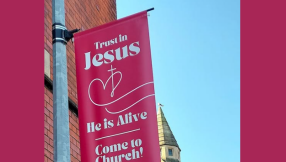
In the beginning, God created humanity so that we might live with him, enjoying and glorifying him eternally. Adam and Eve enjoyed unhindered access to and relationship with God. The entrance of sin into the world changed all that – Adam and Eve found themselves cast out of Eden, away from God’s presence, with no way back.
In one sense or another, the rest of the Bible tells the story of how God re-establishes relationship with human beings. He longs to dwell with us, and he makes a way for us to be present with him. A key means for re-establishing his presence is through the tabernacle and later the temple. These Old Testament sanctuaries are hugely important for the New Testament writers as they seek to make sense of who Jesus is and what he came to do.
One example is John’s Gospel. Jesus speaks of the ‘body of his temple’ in John 2. He is saying that his human body is the dwelling place for the divinity, the way in which God has come near to be with his people again. This ‘temple Christology’, the idea of ‘Jesus-as-temple’, is hugely important in John and has often been noticed. Alongside it, there is the related idea of ‘heaven-as-temple’. This idea is widespread in the New Testament, building off the longstanding and ancient idea that the earthly tabernacle or temple mirrors heaven (see Exodus 25:9 and 40) or that heaven is or contains a temple (see Ezekiel 40-48).
The ‘Jesus-as-temple’ and ‘heaven-as-temple’ ideas in John are not in competition. Instead, they complement and reinforce each other. In John’s prologue, Jesus is like the divine Wisdom which dwells with God and is sent out from heaven to dwell with God’s people in the temple (compare the deutero-canonical books Sirach 24 and Wisdom of Solomon 9).
In John 1:14 we read, ‘The word became flesh and tabernacled among us.’ In Jesus’s encounter with Nathanael at the end of John 1, he describes himself as Jacob’s ladder from the vision Jacob had at Bethel (literally ‘house of God’) in Genesis 28. The ‘ladder’ is not a rickety wooden affair or a free-standing stone staircase, but rather the steps up the side of a ziggurat or mountain-temple. Jesus is saying that he is the point of connection between heaven and earth.
A similar idea emerges in Jesus’s encounter with the Samaritan woman in John 4, where he states that ‘a time is coming when you will worship the Father neither on this mountain nor in Jerusalem’, because true worshippers will worship ‘in Spirit and truth’. Jesus and the Spirit give the access to the heavenly holy space that was previously available only through the earthly temple.
The ‘heaven-as-temple’ idea is most evident in John 14, where Jesus speaks of his Father’s house (a phrase only used elsewhere in John in chapter 2 to describe the temple). It has many rooms, just as the earthly temple had rooms and chambers alongside it, and Jesus is going in his death and resurrection to prepare a place before returning to take his followers there as well.
In these ways, John draws on temple imagery to signal that, in Jesus, God has fulfilled his intent and promise to find a way to dwell with us – now by his Spirit, and in the future in a renewed creation when Jesus returns to take us to be with him and the Father in a renewed creation.
Rev Dr Nick Moore is the Warden of Cranmer Hall, Durham, and the author of The Open Sanctuary: Access to God and the Heavenly Temple in the New Testament (Baker Academic, 2024)













